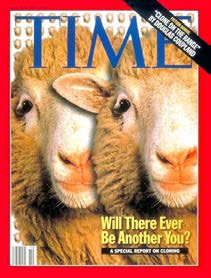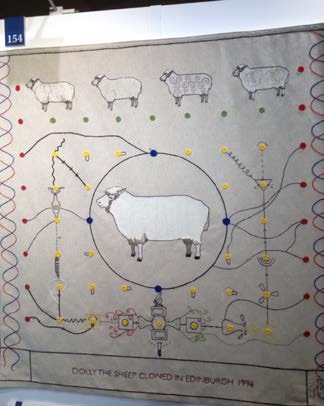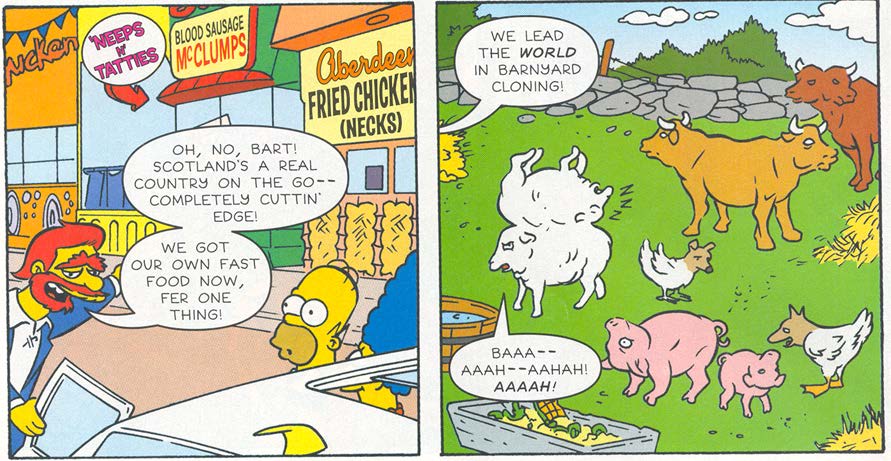V: Dolly the sheep - the first cloned mammal and a public icon for regenerative medicine
Submitting Institution
University of EdinburghUnit of Assessment
Clinical MedicineSummary Impact Type
SocietalResearch Subject Area(s)
Biological Sciences: Biochemistry and Cell Biology, Genetics
Medical and Health Sciences: Paediatrics and Reproductive Medicine
Summary of the impact
Impact: Public engagement and education, influence on public
ethical and scientific policy.
Significance: The first demonstration of cloning from an adult
mammalian somatic cell has stimulated rolling religious, ethical,
cultural, political and scientific debates. Dolly has become a scientific
icon entering the public and educational lexicons in addition to
scientific ones.
Beneficiaries: Human society, culture, education.
Attribution: Wilmut and colleagues (Roslin Institute, UoE),
undertook somatic cell nuclear transfer and used it to perform the first
successful cloning of an adult mammal.
Reach: Worldwide: Dolly became a scientific icon that is
recognisable all around the world, representing a major public engagement
with bioscience. For example; cloning principles are part of high school
education including the International Baccalaureate (implemented in
>3600 schools on five continents).
Underpinning research
Professor Sir Ian Wilmut (Chair of Reproductive Biology, UoE, 1973-2011;
now Emeritus) led the team that used somatic cell nuclear transfer (SCNT)
to create Dolly. This scientific breakthrough is widely recognised as the
key stepping stone between the earlier amphibian-based work of Gurdon and
the reprogramming of adult human somatic cells to a stem cell state
(induced pluripotent stem cells) by Yamanaka.
Wilmut, with colleagues from the Roslin Institute (now UoE), focused
their scientific efforts on the manipulation of eggs (female reproductive
cells), oocytes (egg precursor cells) and stem cells (cells that can
divide and self-renew, but also differentiate into diverse specialised
cell types). They were particularly interested in utilising SCNT to
produce viable embryos. This technique involves transfer of the nucleus
from a somatic cell (any cell that is not a reproductive or stem cell)
into an oocyte or egg deprived of its own nucleus (cytoplast).
In 1994, Wilmut and colleagues discovered that the development of embryos
reconstructed by nuclear transfer is related to interactions between the
donor nucleus and the recipient cytoplasm at the time of fusion and during
the first cell cycle after reconstruction [3.1]. This led to the proposal
of two distinct protocols for embryo reconstruction by nuclear transfer
when using MII oocytes (oocytes at the metaphase II stage of cell
division) as cytoplasts: (i) transfer of nuclei in G1 phase of the cell
cycle into MII cytoplasts containing a high activity of the so-called
maturation-promoting factor (MPF), and (ii) transfer of nuclei in G1, S or
G2 phase into enucleated oocytes after the disappearance of MPF activity
(in the so-called "universal recipient" stage). The group also showed that
it was possible to use microtubule inhibitors such as nocodazole to hold
cells in mitosis before releasing them and using them as nuclear donors as
they passed through G1 phase [3.2, 3.3]. Unfortunately, although this
synchronisation method worked in mice, it proved to be unreliable in
embryos of livestock species. Consequently, Wilmut and colleagues
developed a different approach for the synchronisation of donor nuclei.
The approach was based on serum-starvation of donor cells, which forced
them to arrest in the G0/G1 phase of the cell cycle (the so-called state
of quiescence). This enabled the successful cloning of sheep from cultured
cells derived from sheep embryos. This study was published in early 1996
[3.4]. The same procedure allowed the group to clone a sheep using a
nucleus derived from an adult mammary gland cell. Dolly — the first cloned
adult mammal — was born on July 5, 1996, providing the first evidence that
adult specialised cells are capable of driving the development of a
complete and fertile animal. This first successful cloning of an adult
mammal was reported in Nature in 1997 [3.5] and met with huge and
sustained public and media interest (Fig. 1).
 Fig. 1
Fig. 1
References to the research
3.1 Campbell K, Loi P, Cappai P, Wilmut I. Improved development to
blastocyst of ovine nuclear transfer embryos reconstructed during the
presumptive S-phase of enucleated activated oocytes. Biol Reprod.
1994;50:1385-93. DOI: 10.1095/biolreprod50.6.1385.
3.2 Otaegui P, O'Neill G, Campbell K, Wilmut I. Transfer of nuclei from
8-cell stage mouse embryos following use of nocodazole to control the cell
cycle. Mol Reprod Dev. 1994;39:147-52. DOI: 10.1002/mrd.1080390205.
3.3 Otaegui P, Waddington D, Wilmut I. Nuclear transfer of 4-cell mouse
embryos: synchronisation with cytoplast partially overcomes nuclear donor
cell-cycle effect. J Reprod Fertil Abstr Ser 13. 1994;Abstract 24.
3.4 Campbell K, McWhir J, Ritchie W, Wilmut I. Sheep cloned by nuclear
transfer from a cultured cell line. Nature. 1996;380:64-6. DOI:
10.1038/380064a0.
3.5 Wilmut I, Schnieke A, McWhir J, Kind A, Campbell K. Viable offspring
derived from fetal and adult mammalian cells. Nature. 1997;385:810-813.
DOI: 10.1038/385810a0.
Details of the impact
Pathways to impact
Improvements made to SCNT and the successful cloning of Dolly the sheep
challenged the dogma that the genetic material of specialised cells is no
longer capable of driving the development of a complete animal. This
momentous achievement opened new frontiers in science, technology and
medicine. It also inspired heated debate on the essence of humanity among
scientists, philosophers, religious leaders, politicians and the public.
Dolly the sheep found her place among major scientific achievements and
her legacy continues to have enormous impact. Wilmut has played a key role
in the public engagement surrounding mammalian stem cell cloning,
delivering 49 public lectures since 2008.
Impact on society, public scientific and ethical policy
The realisation that it is possible to clone adult mammals had profound
implications for religious organisations and led to the introduction of
new laws and ethical guidelines. Although many were instituted prior to
2008, the "legacy of Dolly" continues to impact on ethical debate in the
religious, secular and legislative arenas. For example, the cloning of
Dolly is specifically referred to in a recent church position statement:
"A statement of the United States Conference of Catholic Bishops on
embryonic stem cell research" published for the first time in June 2008
[5.1], and in numerous recently published books on ethics [5.2]. "Dolly"
continues to inform governmental thinking and policy: for example, in
2008, the European Group on Ethics of Science and New Technologies (EGE),
in response to a request from the European Commission, issued an opinion
on the ethical implications of cloning animals for food supply [5.3]; and
the Australian government requested a review of its Prohibition of Human
Cloning for Reproduction and Research Involving Human Embryos Acts in
December 2010 [5.4].
Impact on society, public engagement, arts and culture
The life and death of Dolly continues to have a significant impact on art
and culture. For example, a mask taken from Dolly the sheep was one of the
highlights at the Scottish National Portrait Gallery at its reopening
after major renovation in 2011 (11,186 visitors within the first four days
after reopening alone) [5.5], and Krystelle Bamford, a winner of the 2010
New Writers Award, wrote a poem entitled "On the Death Mask of Dolly the
Sheep" that was published in the November 2012 issue of the American
Poetry Review, a major international poetry magazine based in the USA
[5.6]. Dolly and the scientists who created her were also featured in the
exhibition "Cells - the smallest of all portraits", an experimental
learning project involving pupils from Scottish schools (October 29th
2012 - February 3rd 2013, Scottish National Portrait Gallery).
The manner in which Dolly as a scientific icon has caught the public
imagination is unlike few scientific discoveries of the last decades.
Starting with extensive broadsheet coverage, including the cover of Time
magazine (Fig. 1 in section 2), the media interest in and reach of Dolly
has demonstrated extraordinary breadth and durability. Since 2008,
reference to Dolly and cloning have appeared in numerous media relevant to
a wide range of age groups ranging from the "Itchy & Scratchy" cartoon
and "The Simpsons Comic" to the recently completed "Great Tapestry of
Scotland", in which a whole panel is devoted to Dolly to represent
Scottish scientific discovery (Fig. 2).
 Fig. 2 The Great Tapestry of Scotland
Fig. 2 The Great Tapestry of Scotland
 The Simpsons Comic
The Simpsons Comic
Impact on society, public engagement and education
Dolly herself has become a "scientific icon" of UK biomedical science and
is displayed in the National Museum of Scotland in Edinburgh (1.9M
visitors annually). The National Museum of Scotland website lists Dolly as
a highlight, and states that "Dolly has been enormously popular, with
visitors coming from all over the world to see her. She has even travelled
to Hungary to open a new science museum in Budapest!" [5.7].
The principles of SCNT are now part of the science curriculum at high
school level in the UK and other countries. Notably, they have been
integrated into the International Baccalaureate (IB) Diploma curriculum
[5.8], a two-year educational programme primarily aimed at students aged
16-19 that provides an internationally accepted qualification for entry
into higher education, and is recognised by many universities worldwide.
IB courses are available in 3628 schools in Europe, North America, South
America, Asia and Africa [5.9].
Impact on society, public science policy
Dolly played a major role in clarifying the value of stem cell and
regenerative medicine research to Government, contributing to the
establishment of several high-profile initiatives including the UK Stem
Cell Initiative chaired by Sir John Pattison. More recently, in autumn
2012, the Chancellor of the Exchequer identified Eight Great Technologies
of strategic importance to the UK and announced an additional funding of
£600M to help support their development. Regenerative medicine is placed
among these great technologies and the influence of Dolly the Sheep and
Edinburgh's research was highlighted in a speech by the Minister for
Universities and Science (the Rt Hon David Willetts MP) delivered on
January 24, 2013 at the Policy Exchange [5.10].
Sources to corroborate the impact
5.1 A statement of the United States Conference of Catholic Bishops on
embryonic stem cell research. USCCB Publishing, Washington, D.C., 2008.
http://old.usccb.org/prolife/issues/bioethic/bishopsESCRstmt.pdf.
5.2 Examples of major books on ethics that specifically mention the
cloning of Dolly the sheep [available on request]:
- Ravitsky V, Fiester A, Caplan A. The Penn Center Guide to Bioethics.
Springer Publishing Company, New York, USA, 2009.
- Morrison E. Health Care Ethics: Critical Issues for the 21st Century,
second edition. Jones and Bartlett Publishers, London, UK, 2008.
5.3 The European Group on Ethics in Science and New Technologies to the
European Commission Opinion 23 - Ethical aspects of animal cloning for
food supply, 2008.
http://ec.europa.eu/bepa/european-group-ethics/docs/publications/opinion23_en.pdf.
5.4 Report of the Independent Review of the Prohibition of Human Cloning
for Reproduction Act 2002 and Research Involving Human Embryos Act 2002 -
A Report to the Parliament and the Council of Australian Governments,
2011.
https://legislationreview.nhmrc.gov.au/files/legislation_review_reports.pdf.
5.5 Record number of visitors to Scottish National Portrait Gallery, STV
news, 6 December 2011 by Clare Carswell. http://news.stv.tv/east-central/285503-scottish-national-portrait-gallery-announces-record-number-of-visitors/.
[Corroborates number of visitors to gallery.]
5.6 Bamford K. On the Death Mask of Dolly the sheep. American Poetry
Review. Nov/Dec 2012;41:46. [Available on request.]
5.7 National Museum of Scotland website.
http://www.nms.ac.uk/our_collections/highlights/dolly_the_sheep.aspx.
5.8 Walpole B, Merson-Davis A, Dann L. Biology for the IB Diploma.
Cambridge University Press 2011. [Available on request. International
Baccalaureate diploma programme textbook; Dolly mentioned on page 94].
5.9 Statistics available from the website of the International
Baccalaureate Organisation.
http://www.ibo.org/facts/schoolstats/progcombinationsbyregion.cfm.
5.10 Policy: Investing in research,development and innovation; Speech:
Eight Great Technologies, Minister: The Rt Hon David Willetts MP; Date: 24
Jan 2013; Place: Policy Exchange; Transcript: https://www.gov.uk/government/speeches/eight-great-technologies.